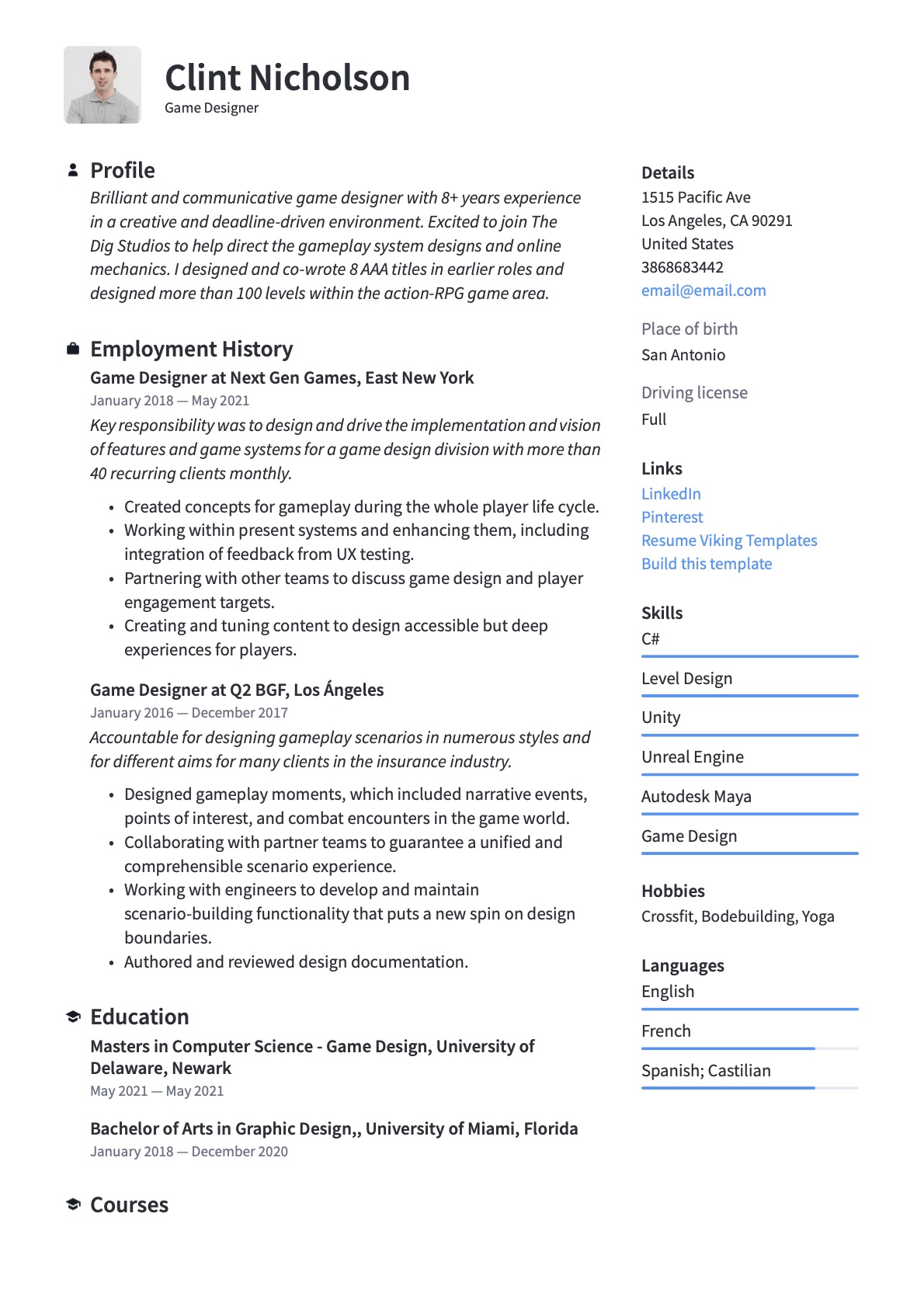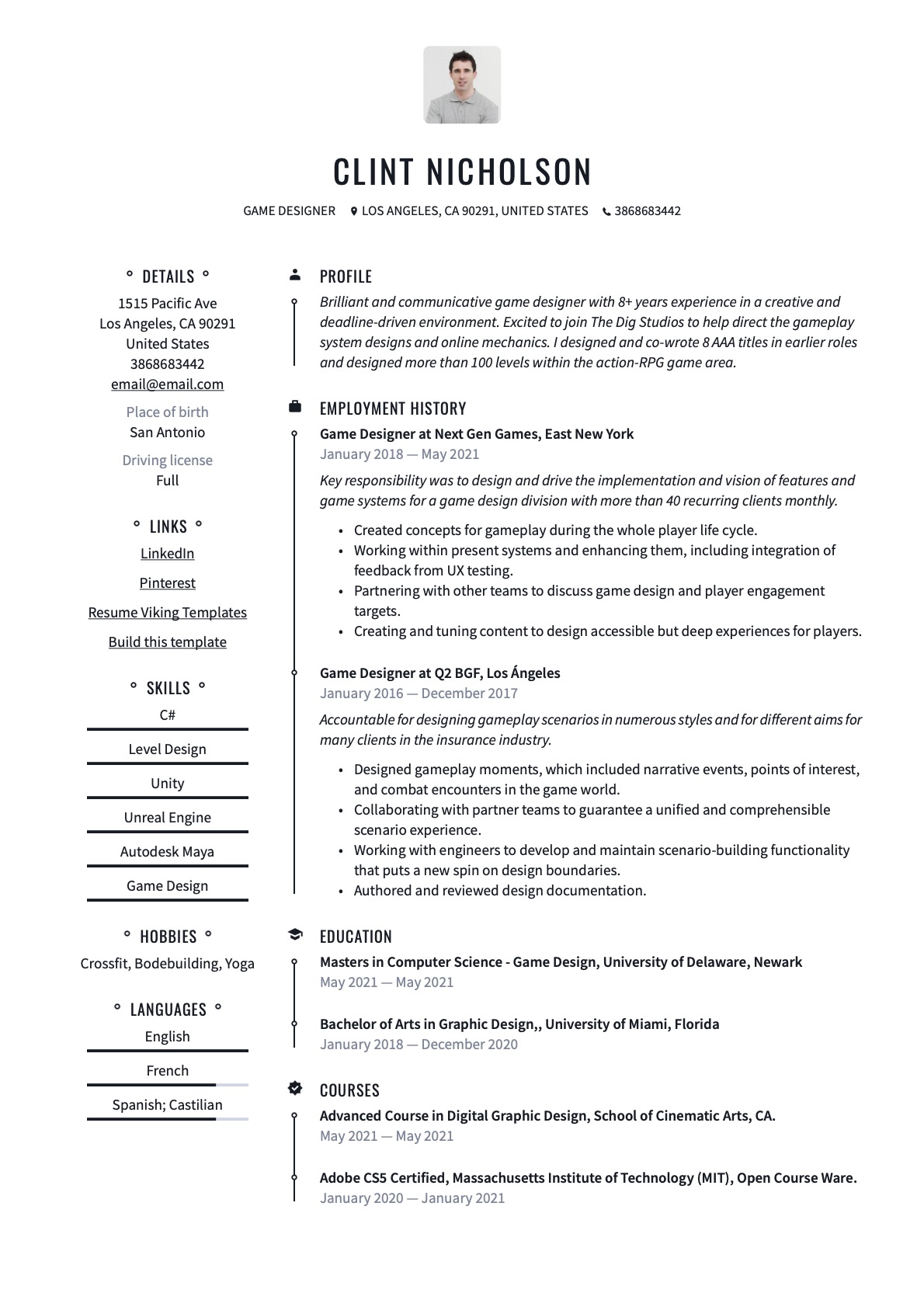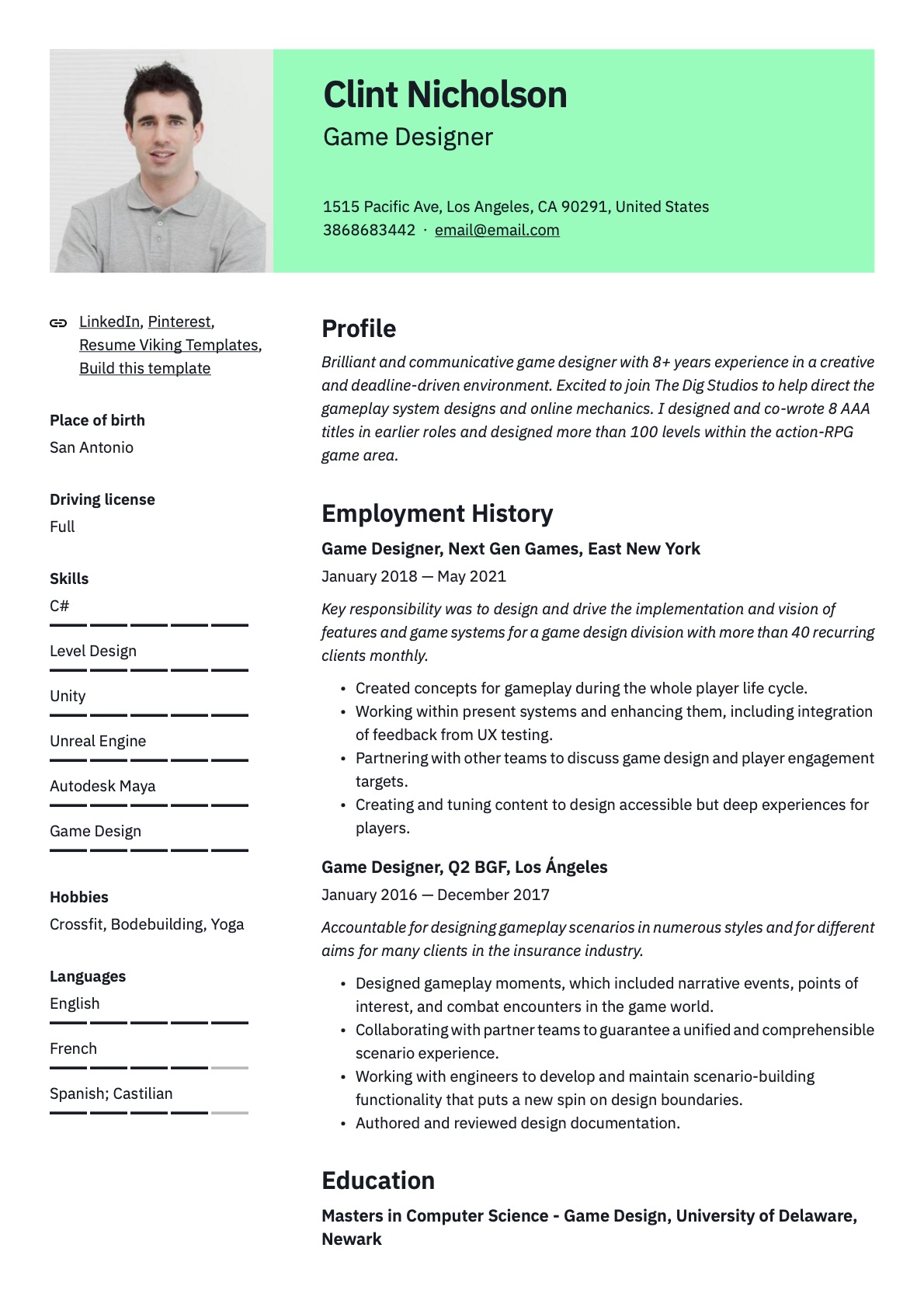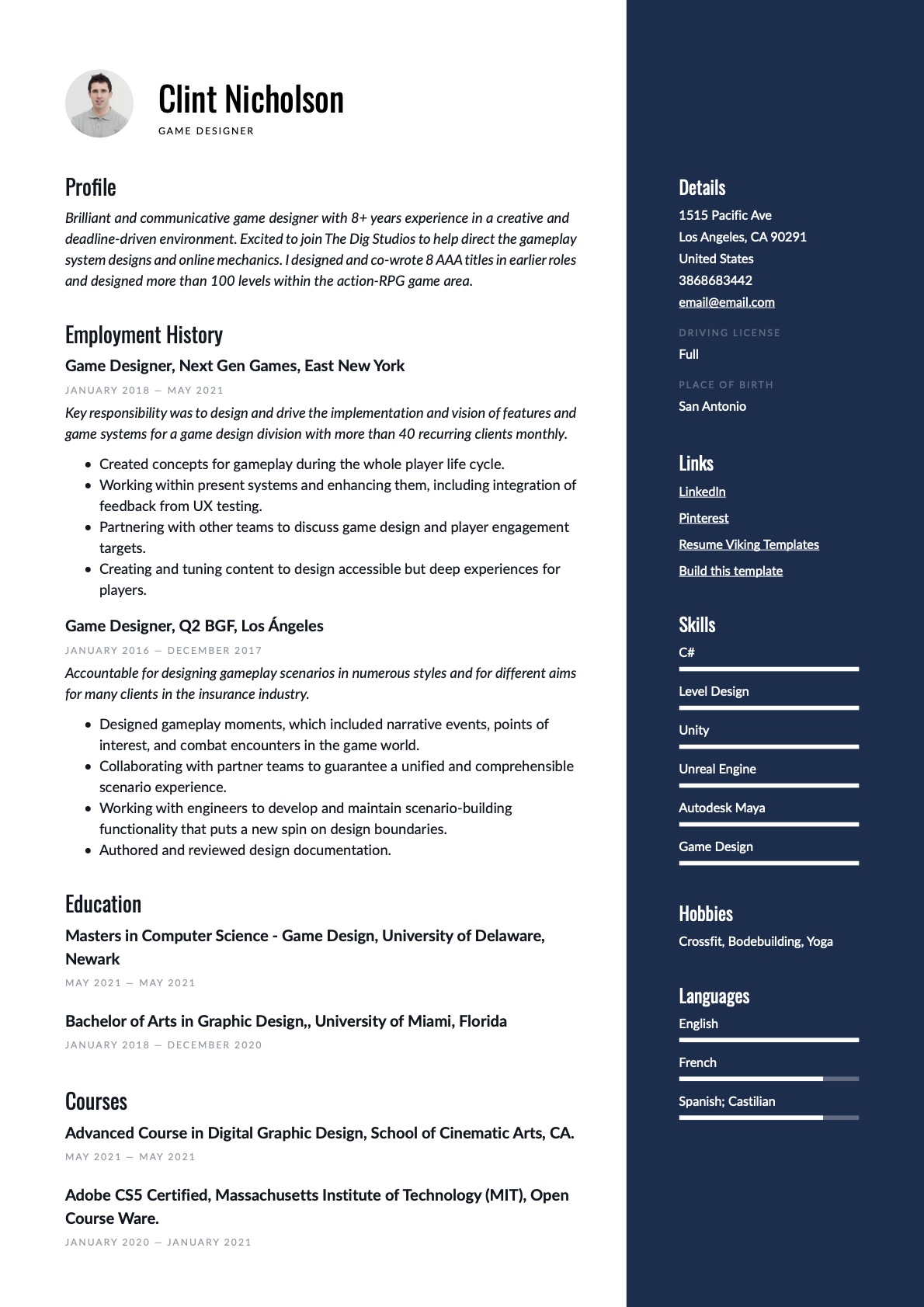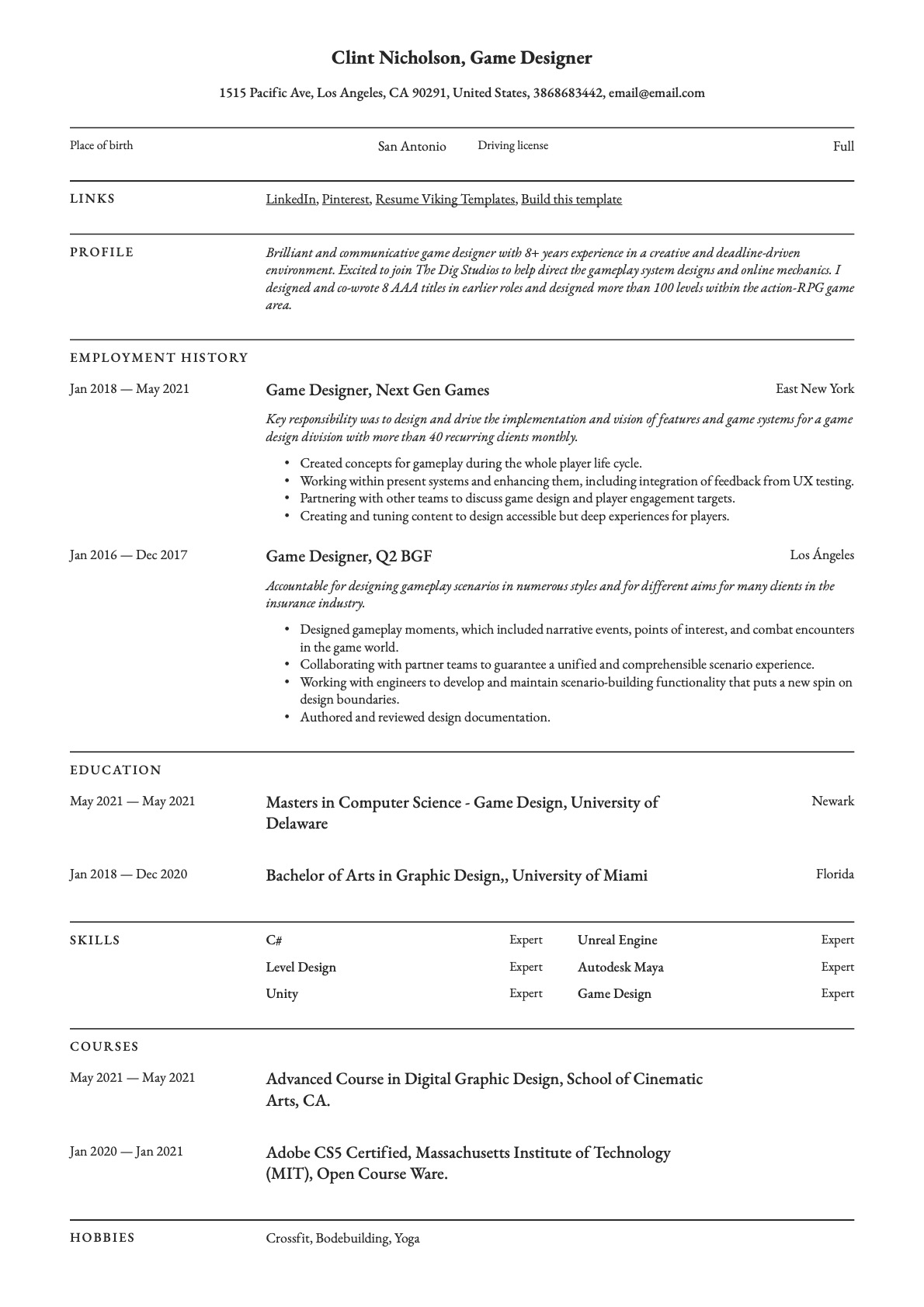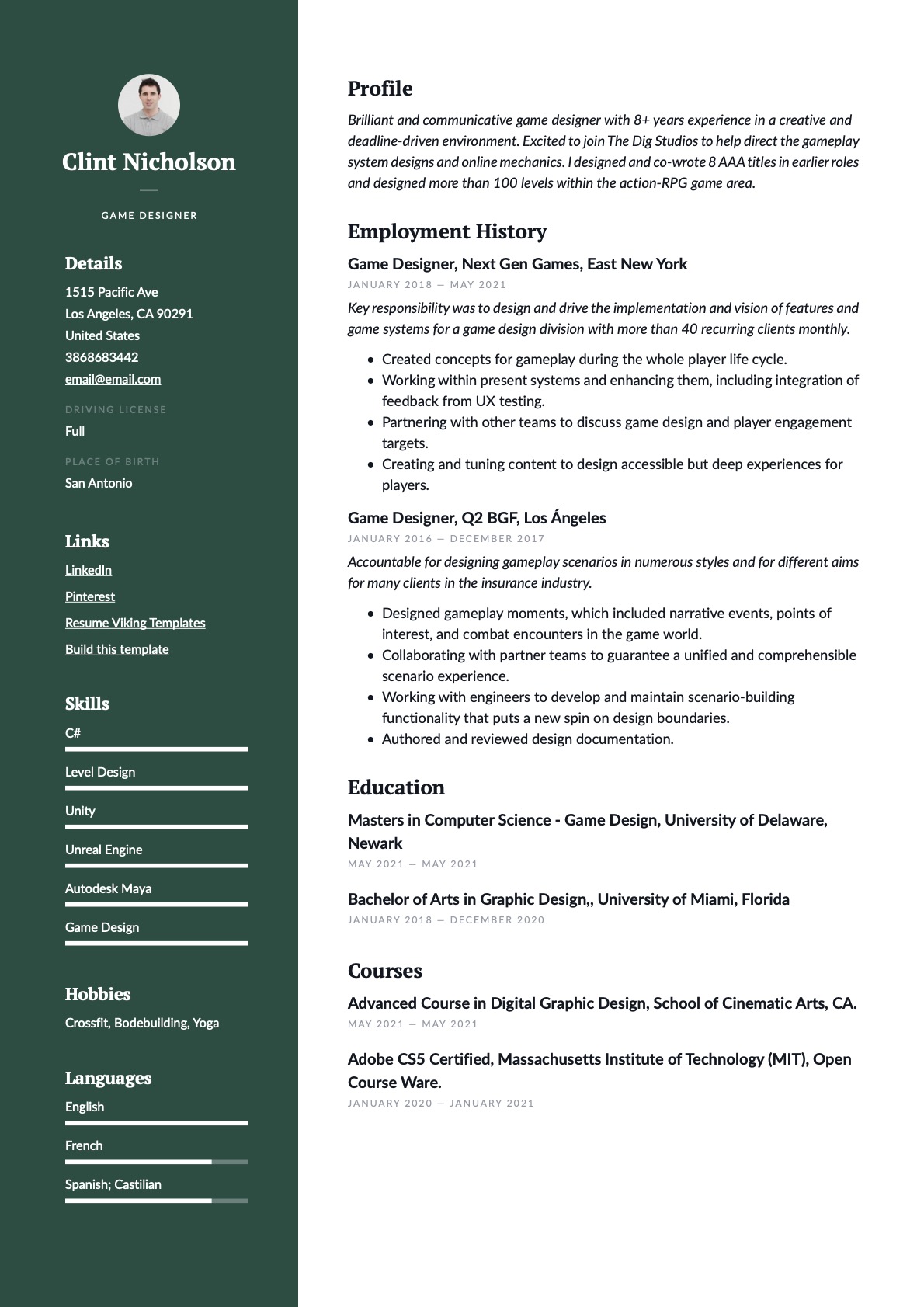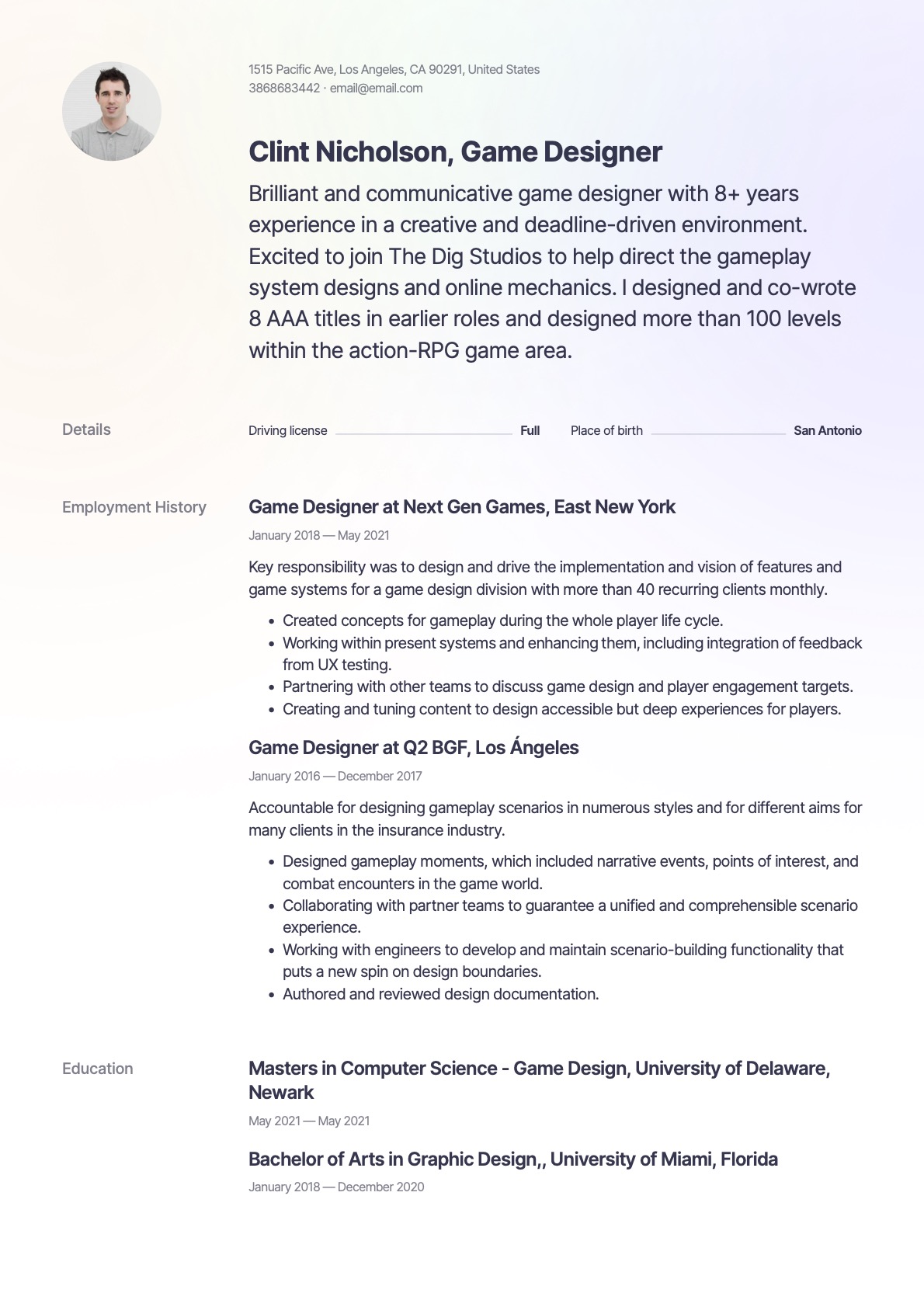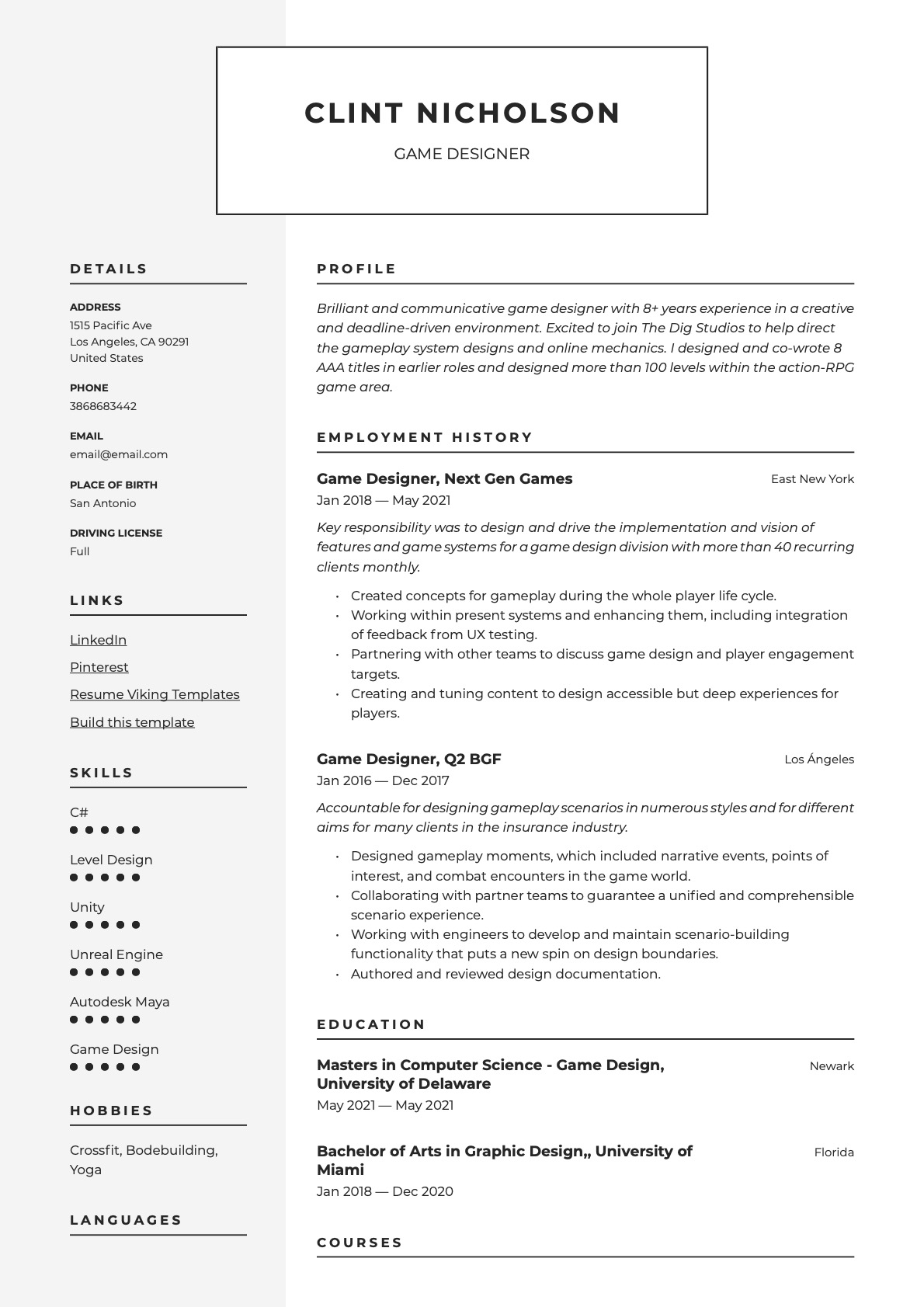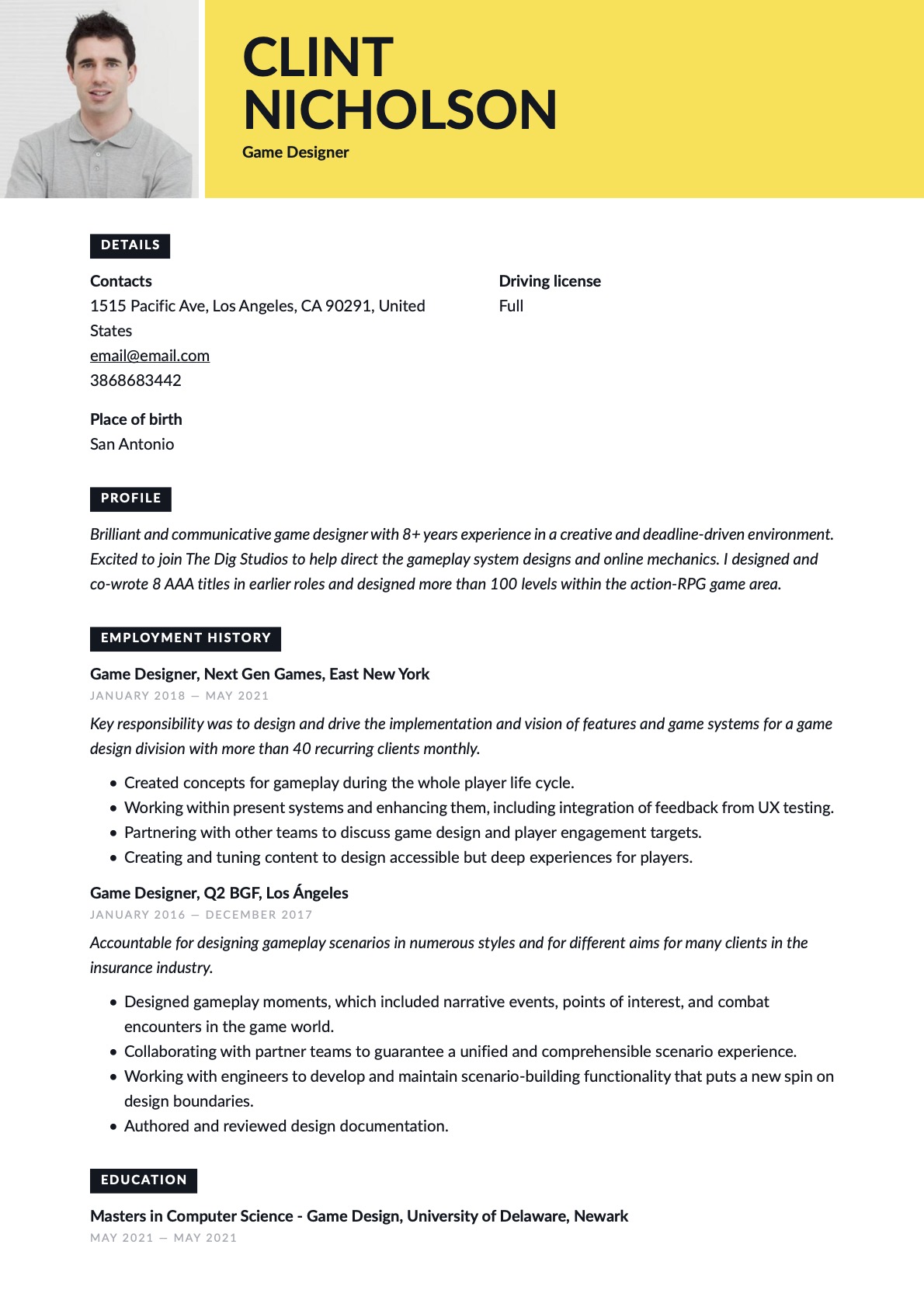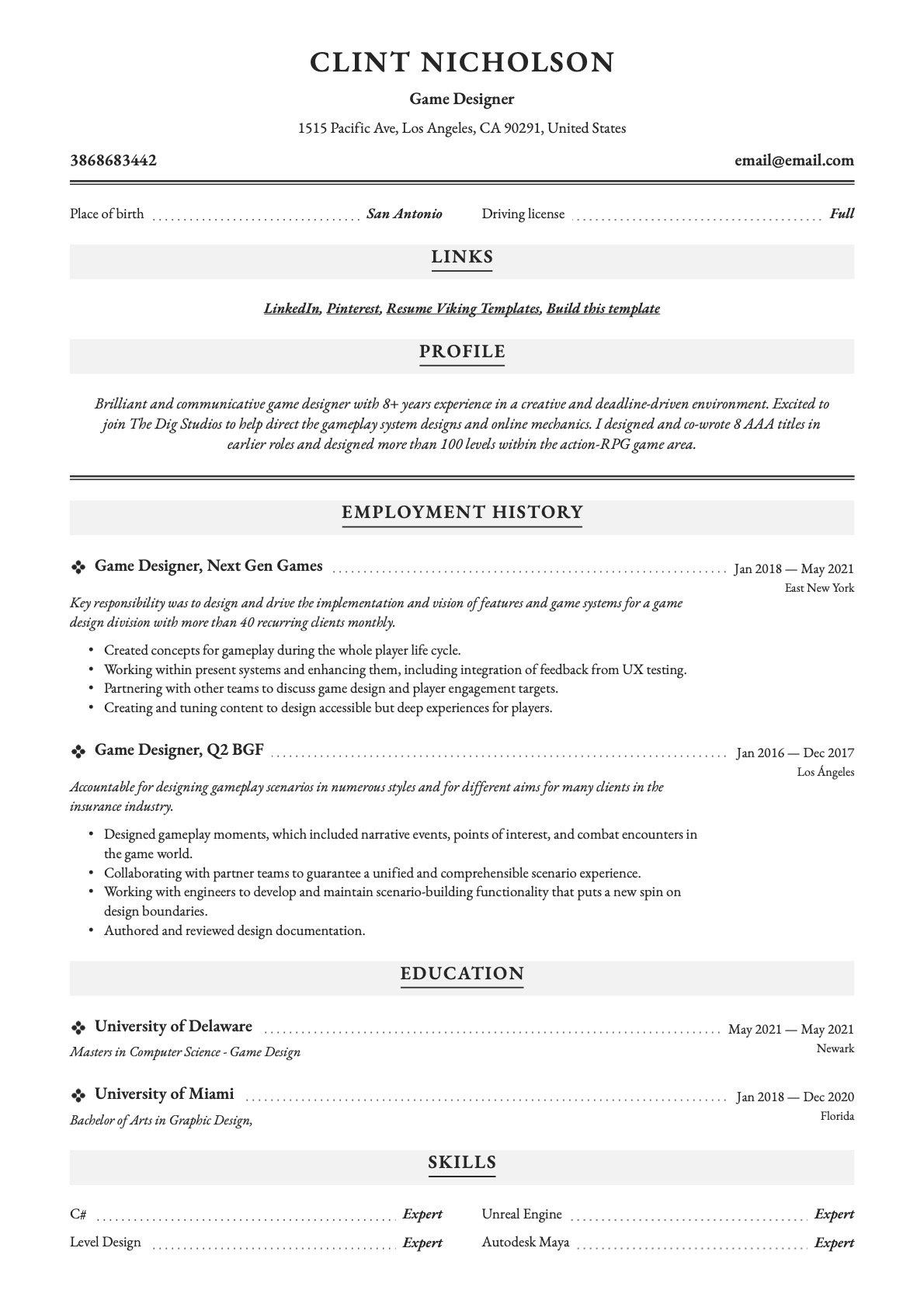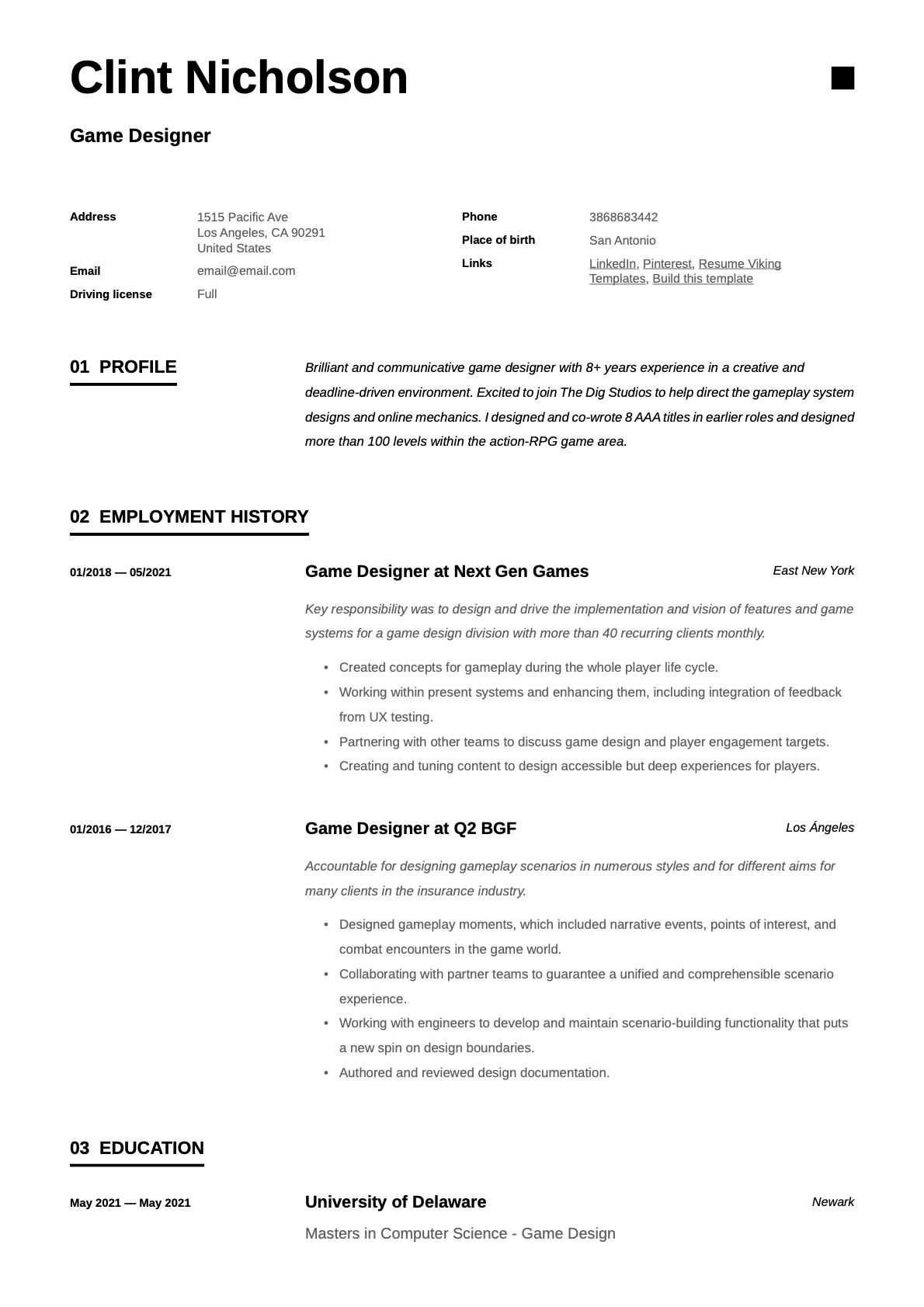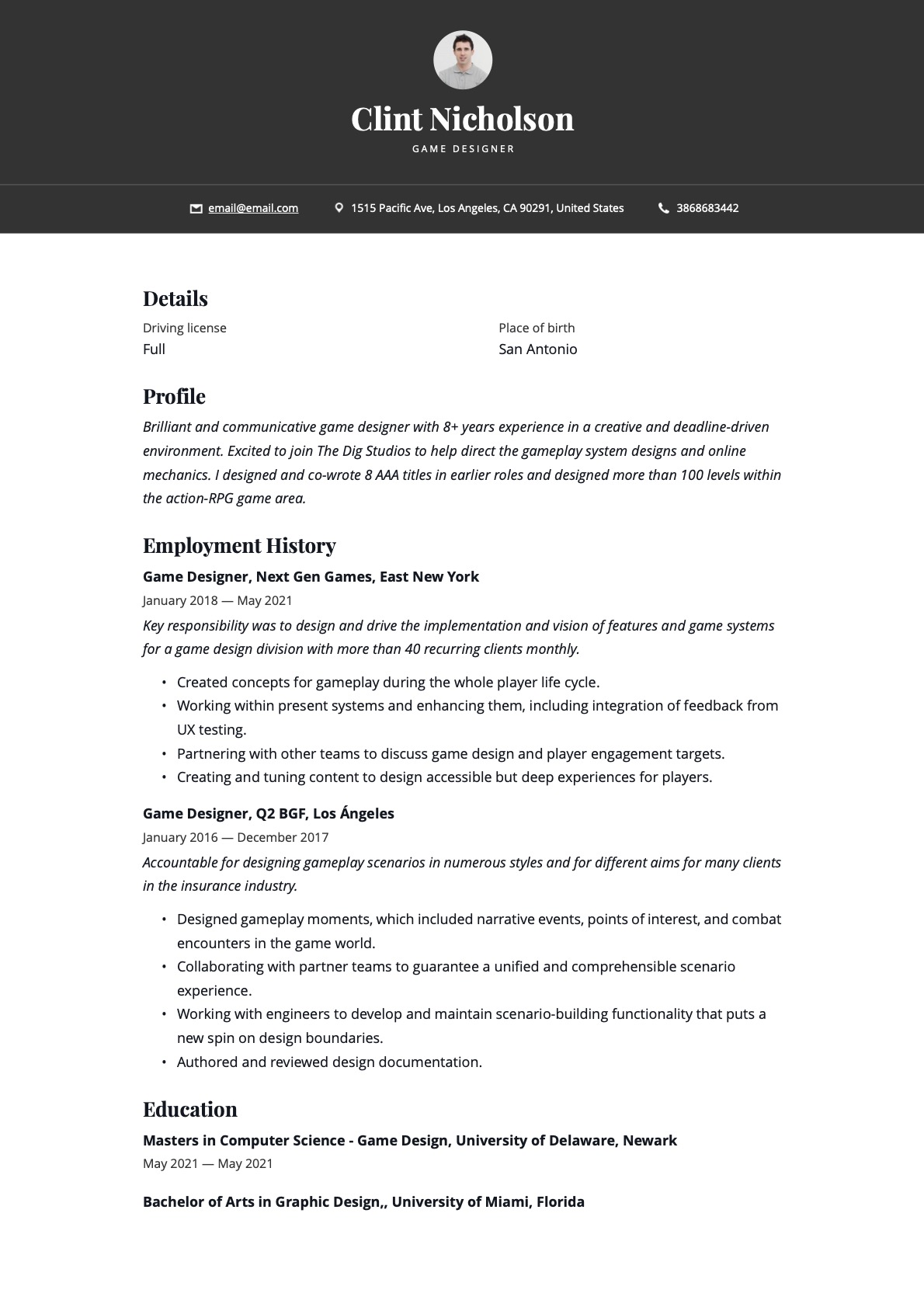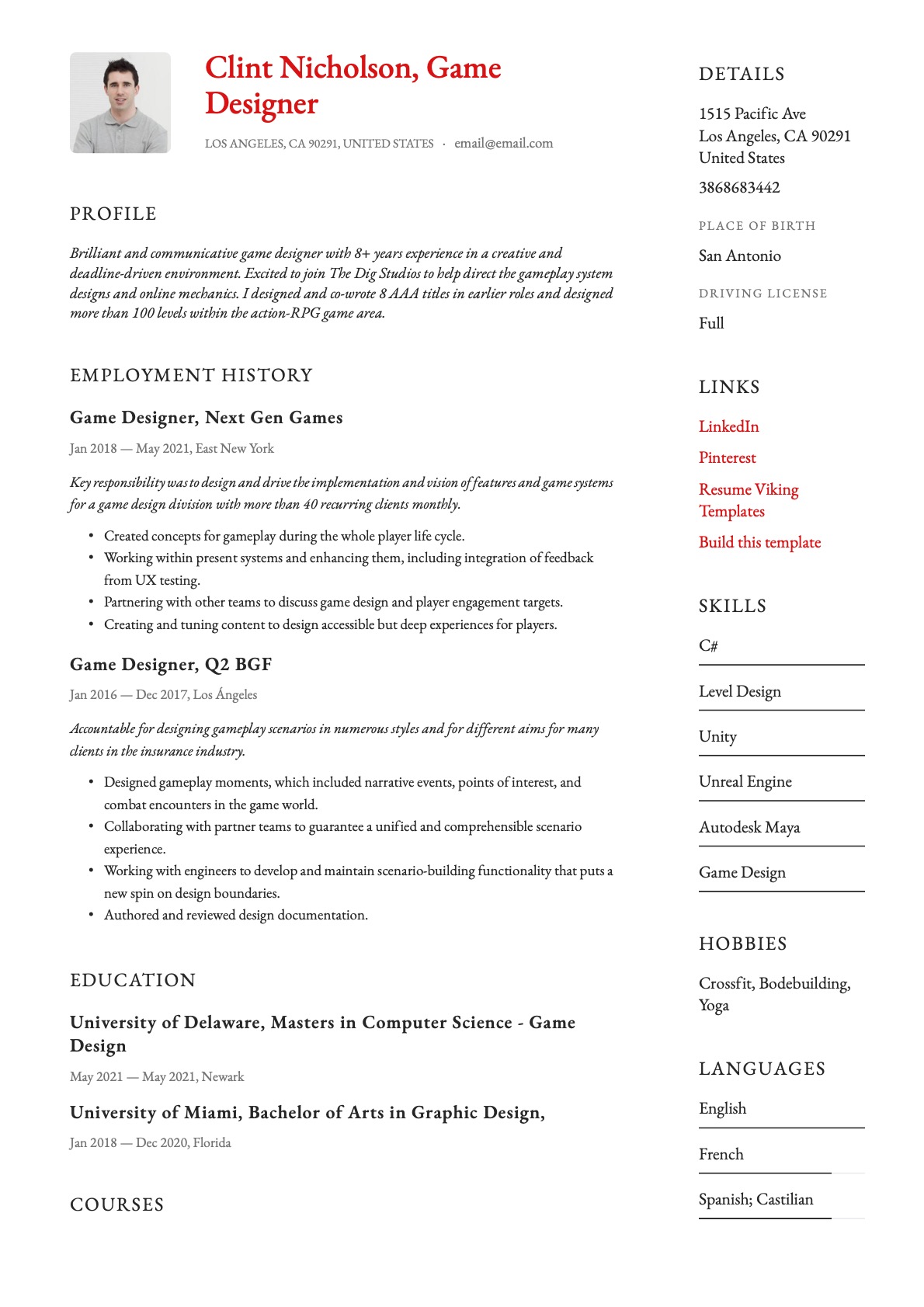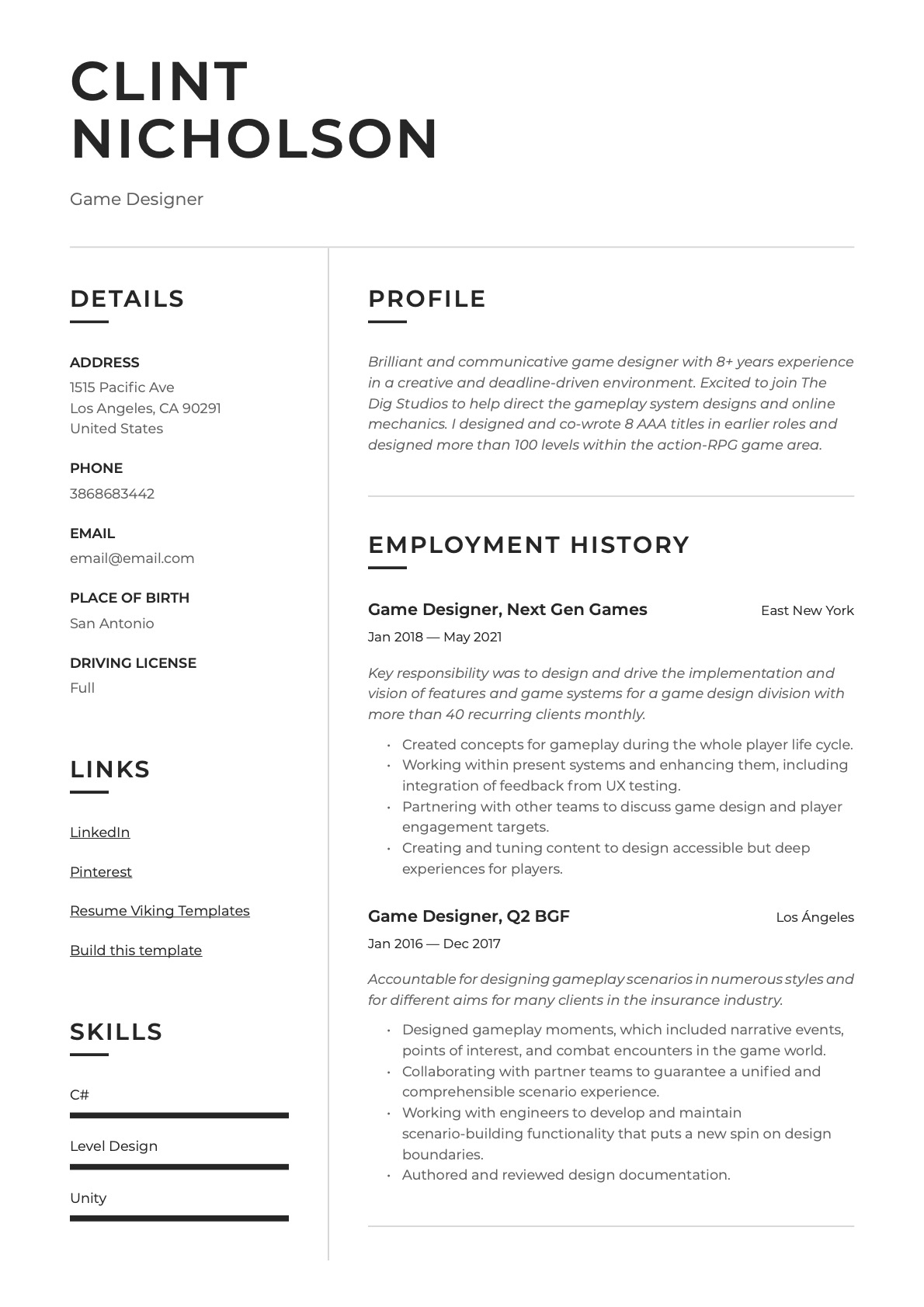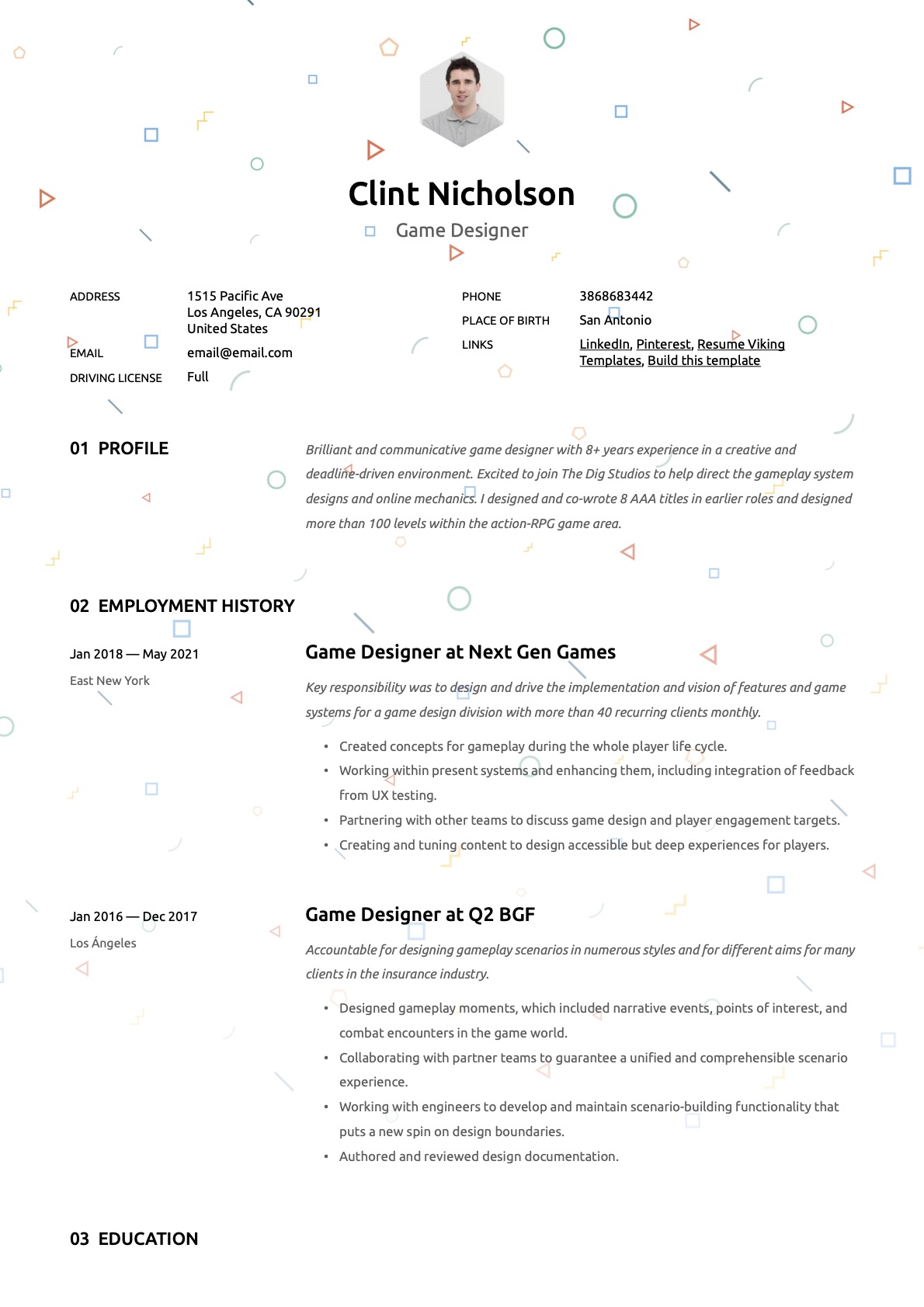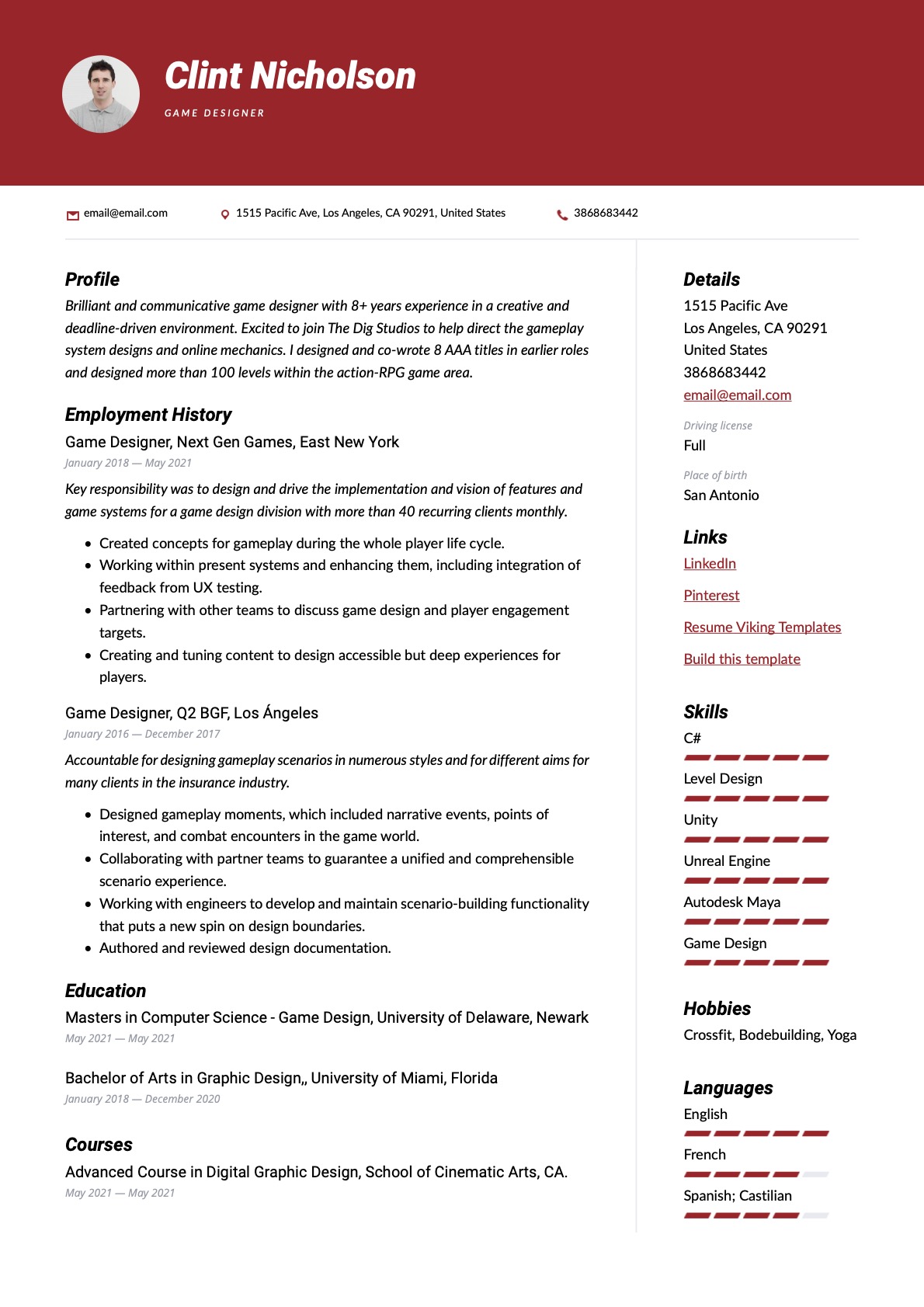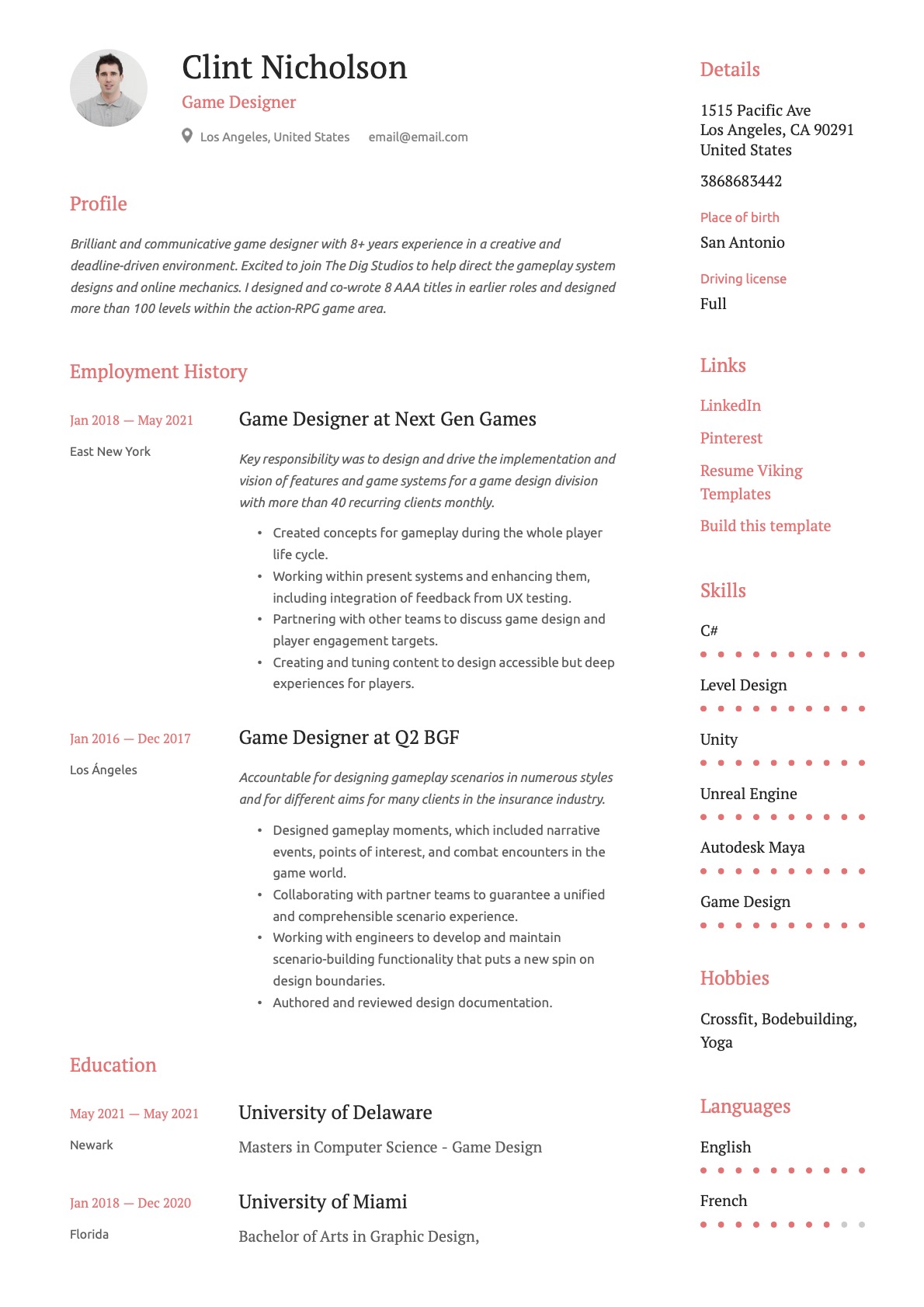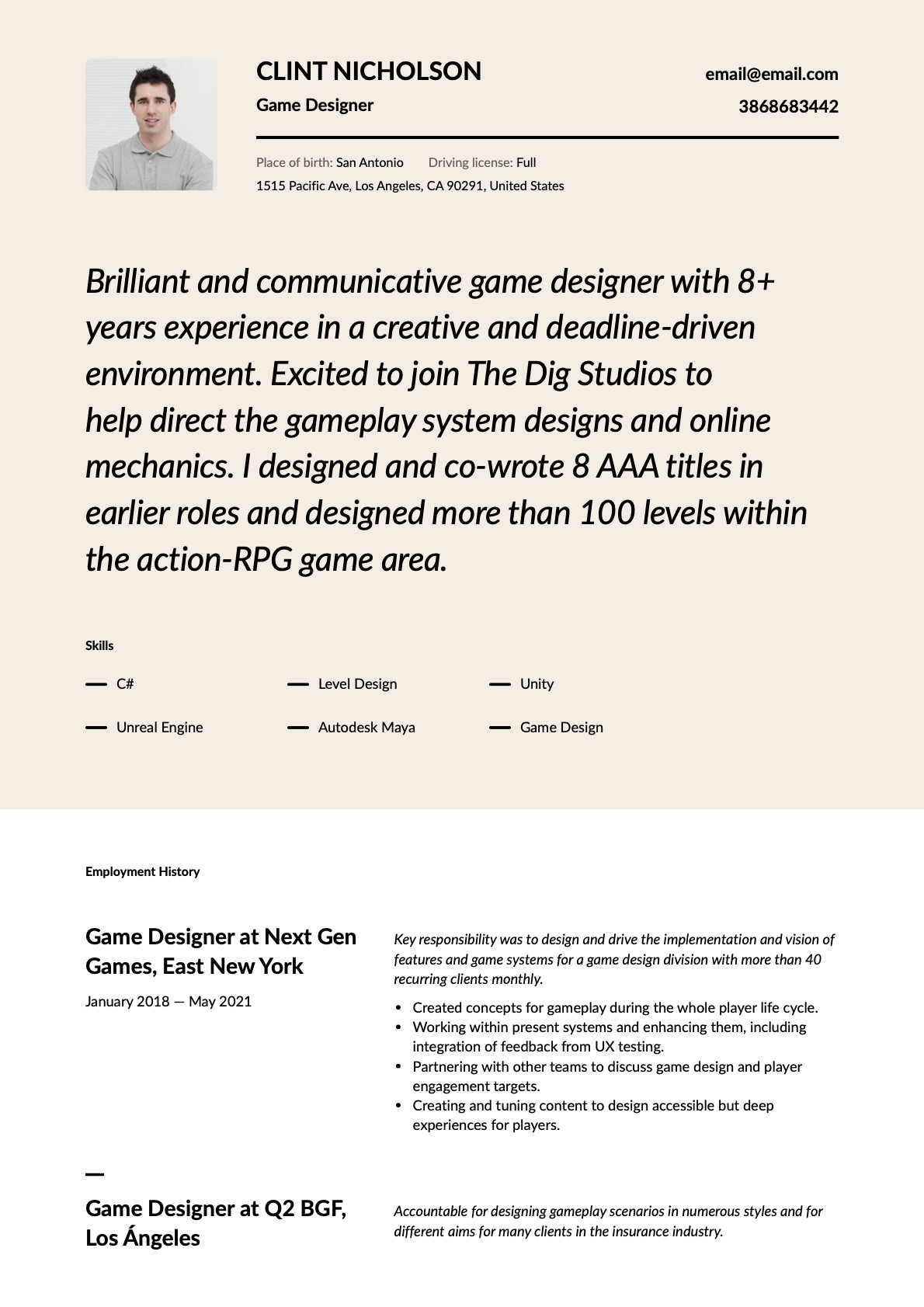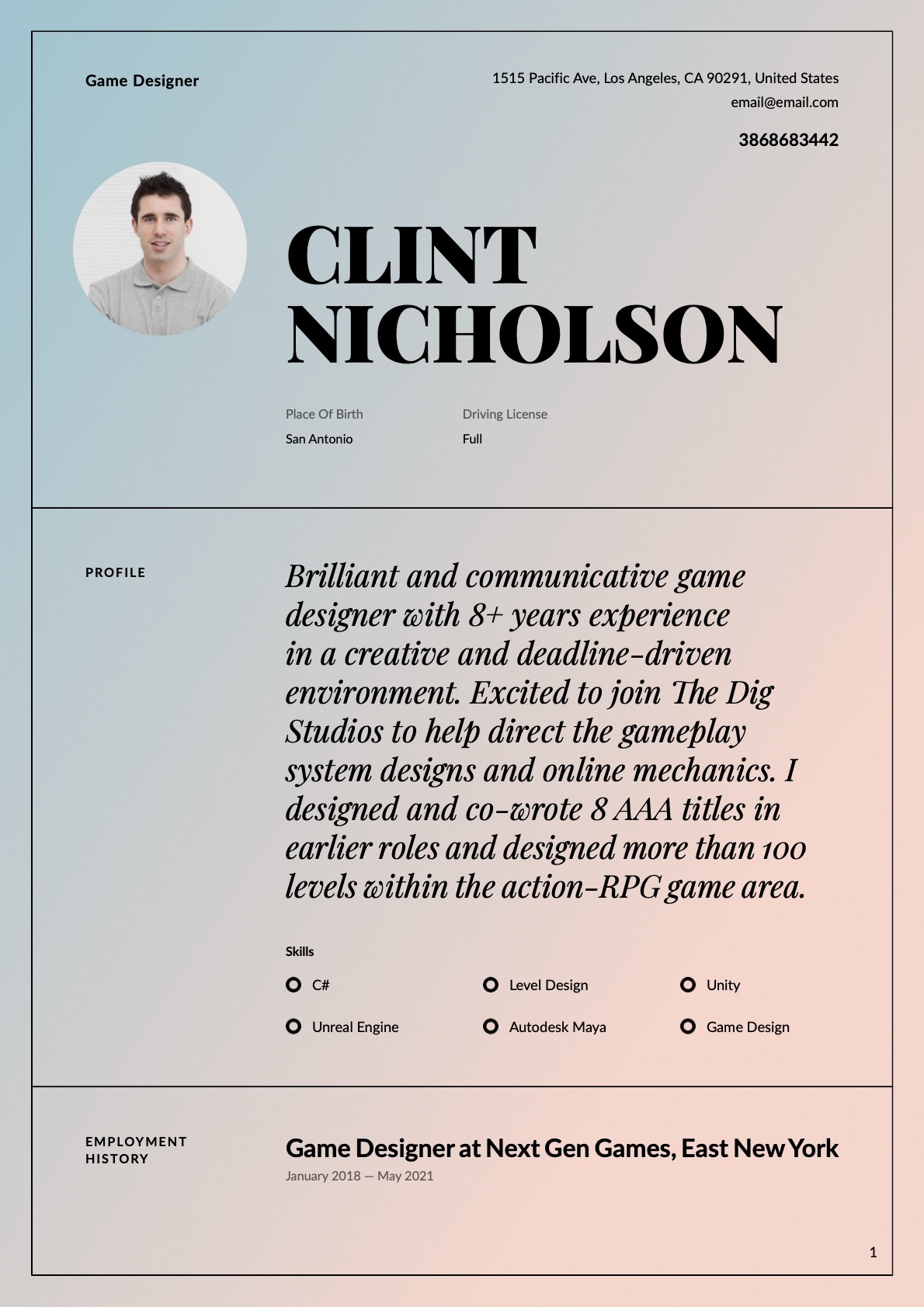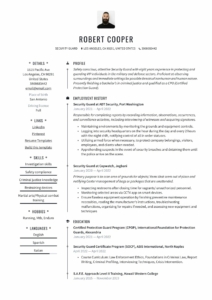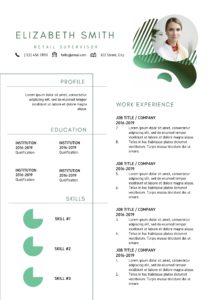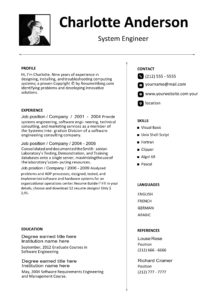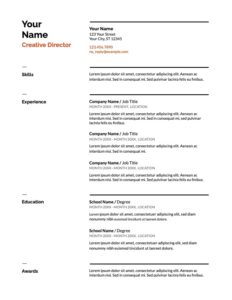When looking for your new Game Designer job, it’s critical that you check out what a good example of a Game designer resume looks like.
Our Game Designer guideline has everything you need, including instructions, tips, and examples to ensure you have the best information to draw up a Game Designer resume good enough to use as a stencil for all those coming behind you!
Because let’s be honest, all your creative flair in your resume won’t mean jack if what you include isn’t relevant info.
What you can read in this article
20 Game Designer Resume Examples
(Free sample downloads are at the bottom of this page)
Game Designer Resume Writing Guide
Resume Sections:
- Contact information
- Career objective & summary
- Employment History
- Achievements
- Education
- Skill Section
- Certification & Licensing
- Extras: Languages/Awards/Publications/Volunteering/hobbies
- > Professional information
1. Contact information
- First Name and Last Name
- Physical Address
- LinkedIn Profile / Portfolio Link
What to Highlight in a Game Designer Resume
Probably the best piece of advice we can give you is to make your resume “job specific.” Look at the job advert. It will tell you what they are looking for. You must copy and paste the exact words used in the job ad to ensure you align with their requirements.
For example, if the ad says they’re looking for someone with “advanced C++ coding abilities,” then use those exact words in your skills section (if it applies to you). The whole point of the resume is to make them want to see more of you and schedule an interview.
Sometimes, up to 80% of resumes never make it to the recruiters because they don’t pass the ATS (applicant tracking system) bots scanning your resume for the keywords and phrases we spoke of in the above paragraph, so please, guys, tailor your resumes to the particular job.
Other than complying with the ATS, you must showcase particular features of your experience. Having a creative talent for visual aesthetics will only get you so far. When choosing what to include, be specific and concise. If you want to nail this resume design, follow these guidelines:
- Start your resume with your best header. Keep in mind that you don’t have to include your address. Either an email or phone number will do.
- Your resume sections must be clearly labeled and easy to read.
- Use the reverse chronological format as this presents your latest and most applicable info first.
- Keep your fonts easy to read and simple. Flashy won’t really do here.
- Keep the resume to 2 pages max, one if you can. Only out relevant info in, don’t waffle on about irrelevant things.
- Even if it isn’t specified, send your resume as a pdf.
You want to catch their attention with your main proficiencies. A skills section comes later on, but you have to explain these skills to achieve the desired effect in this industry.
- Creativity: This deceptive little word seems like the perfect one, to sum up, your skills, but it’s not. You must explain how you create new ideas and groundbreaking game designs. Include links to your online portfolios/ Insta account and a couple of tools such as InDesign/ Photoshop.
- Communication: A typical generic skill, so elaborate on how good you are. Give examples of how you understood clients’ requirements and navigated what they wanted vs. what was actually possible. Communicating with clients who may well know nothing about the design process is vital in this industry.
- Adobe’s Creative Apps: Yeah, being proficient with this is pretty much non-negotiable, with recruiters assuming you have these skills already. You know what they say about assumptions, though, so elaborate on how kick-ass you are with Indesign, Illustrator, and PhotoShop software by giving a couple of examples of your latest projects.
- Interactive Media: in the digital century, engagement is the whole point. Include your experience with interactive media design, for instance, designing moving imaging and text, video, animation, audio, or gamification inserted into websites, interactive signage, or online advertisements. Provide examples with links to your online portfolio. Make sure to include User Experience (UX) and User Interface (UI) abilities too.
- Coding: You might not have to be NSA level here, but you enjoy the whole creating lines of code and scriptwriting, then include your tenure with C++, HTML, and Java, as this will put your resume above those who don’t really focus on this.
2. Career Summary & Objectives
It is essential to tailor your career summary/ objective to the individual jobs you apply for. This sounds like a boatload of effort but trusts us, quality over quantity is what’s going to get you that interview.
Your career summary should be laid out like this:
- Your first sentence must have a solid adjective labeling yourself in terms of your latest position and experience level.
- Then give 2 or 3 key technical proficiencies and the kind of industry your experience was attained.
- Finish up with a sentence about credentials and qualifications.
Your summary should always be in the third person, just like the rest of your resume. The summary/ objective is basically your demo saying what’s great about you, so keep it professional.
Now, you can either write a career summary or a career objective:
If you have a few years (like more than 2) experience in the industry to speak of, then write up a summary. It focuses on your accomplishments and experience.
If you have less than two years’ experience, write up an objective. It focuses on your proficiencies and elaborates how you’ll be able to do the job better than the competition. It’s definitely better to include numbers to quantify your summary/ objective.
*Pro Tip: Write your summary/ objective after your entire resume. That way, all your info is laid out, so you know what to include in your summary/ objective.
Examples
Game Designer Summary 1
“Brilliant and communicative game designer with 8+ years experience in a creative and deadline-driven environment. Excited to join The Dig Studios to help direct the gameplay system designs and online mechanics. I designed and co-wrote 8 AAA titles in earlier roles and designed more than 100 levels within the action-RPG game area.“
Game Designer Summary 2
“Looking for a position as a Computer Game Designer where I can utilize my proficiencies and understanding in the field towards the development and growth of the company. Highlights of Qualifications: Outstanding experience in Production, Design, and Development of Computer games.“
Game Designer Summary 3
“Proficient Game Designer with 9+ years’ experience can create quick, efficient prototypes of novel and interesting gameplay mechanics as a part of an innovative children’s app project. A promoter for the player, championing sophisticated design and fun yet respecting parallel project goals. Works attentively with the designers, writers, animators, producers, and engineers to design gameplay mechanics encompassing wide age groups and skill levels.“
Game Designer Summary 4
“Game Designer with 4+ years’ professional game/ app development experience. Extensive knowledge of apps and games across many genres, from mainstream to independent, from core to casual. Capable and keen to employ the knowledge of “what works” to the expanding field of educational games. Can present concepts efficiently to teams using a combination of oral, visual, and written communication.“
3. Employment History
Right, so believe it or not, your experience in the game isn’t the only thing that matters right now. Describing your work experience properly in your resume is also critical.
You MUST mold your resume to every individual job application. The correct format looks like this.
- Use reverse chronological format, putting your most recent job first in your game designer resume.
- Include the company’s name, location, and the dates you worked there as well.
- Describing your achievements and obligations using bullet points is fine. However, about 4-6 bullets should do per job.
- Utilize attractive resume words such as created, built, developed, authored, etc.
- Only include relevant jobs. Leave out anything that doesn’t fit the bill.
Samples
Game Designer at NextGen Games, New York, NY
March 2015- April 2019
Key responsibility was to design and drive the implementation and vision of features and game systems for a game design division with more than 40 recurring clients monthly.
- Created concepts for gameplay during the whole player life cycle.
- Working within present systems and enhancing them, including integration of feedback from UX testing.
- Partnering with other teams to discuss game design and player engagement targets.
- Creating and tuning content to design accessible but deep experiences for players.
Gameplay Designer at Q2 BFG, Los Angeles, CA
January 2011- February 2013
Accountable for designing gameplay scenarios in numerous styles and for different aims for many clients in the insurance industry.
- Designed gameplay moments, which included narrative events, points of interest, and combat encounters in the game world.
- Collaborating with partner teams to guarantee a unified and comprehensible scenario experience.
- Working with engineers to develop and maintain scenario-building functionality that puts a new spin on design boundaries.
- Authored and reviewed design documentation.
Job Descriptions Examples
This section may be the difference between an interview vs. no interview. Get creative here with things like images, infographics, and URLs of all the cloud portfolios you mentioned in your other resume sections. Keep your sentences concise and proper when describing your job duties.
An Associate Game designer (fewer than five years’ experience) may be:
- Designing item drop images, notifications, “game over” screen, the company name title, and tree health meter in Photoshop.
- Developing the game's theme and story and contributing to the team's living GDD.
- Writing scripts for tree's health, “new wave” countdown, platform movement, sound controllers, and much more.
- Prototyping five fully playable levels very quickly and cutting one due to time and technical restraints (enemy pathing).
- Balancing wave systems, level design, item drop percentage, difficulty, fun, and pacing.
A Game designer at the mid-career stage (5-10 years’ experience) may include:
- Creating new game experiences interaction paradigms for Kinect, control systems, becoming the fastest-selling consumer electronics device in history.
- Prototyping gameplay mechanics for Reflex Ridge and Rallyball activities in pack-in title Kinect Adventures.
- Inventing ways of describing the idea of a “play space” and the player's position within it were adopted across numerous studios and launch titles.
- Acting as design liaison from EA Sports Studios to the Kinect reserved gesture team, which resulted in choosing a gesture that reduced gameplay conflicts.
- Collaborating with User Research team creating questionnaires, noting user research sessions, examining playtest results, and repeating based on player feedback.
- Presenting Kinect Avateering talk to audiences of more than 1000 professional game developers at EA Sports Gamefest.
A Lead Game designer at the experienced/ advanced stage (10-15 years’ experience) may include:
- Successfully leading five individual projects from beginning to completion and creating professional ideas that attained contracts with publishers and generating income for the company.
- Establishing the design vision for several projects on the Xbox 360, Wii, DS, Ultimotion platforms, and SPG while preserving the quality of license and design throughout every project.
- Designing levels, spawn placements/ enemy encounters, and boss A.I.
- Designing 3 Ultimotion titles with accelerometer technology due to researching body movement in games.
- Setting up design meetings every week to incite better communication between the designers helps to conjure concepts for all projects and allows for the enhanced allocation of design resources.
- Establishing relationships with publishers and improved competence in communication between the studio and them.
4. Accomplishments
This section is sort of your “proof of concept.” Take your best skills and then explain them using power verbs but link them to achievements you’re most proud of in your latest/ previous workplace. This includes accolades, awards, recommendations from clients, etc.
We know that sometimes, creative brains aren’t great with figures and facts, but in this section, you MUST quantify your statements to give the recruiters something objective to measure your proficiency levels.
This is your self-promotion section, your time to make your brand shine, so attach links to your portfolio/ website/ Insta, etc.
Quantification:
Make your resume flashy with some numbers! Throw some numerical values into your statements to impress the recruiters.
Below are some examples of accomplishment statements WITH quantification:
- Created and co-wrote 7 AAA-released game titles.
- Enhanced players' success rate by 170% from working closely with the UX team, designing many measurable tests and questionnaires.
- Designed a method for data-gathering for game tuning and balancing, which enhanced the user experience rating by 49%.
- Designed over 170 levels for several Fantasy Action-RPG and Sci-Fi games.
Now, check what happens when you take the numbers away:
- Created and co-wrote AAA released game titles.
- Enhanced players' success rate by working closely with the UX team and creating many measurable tests and questionnaires.
- Designed a method for data-gathering for game tuning and balancing, which enhanced the user experience rating.
- Created many levels for various Fantasy Action-RPG and Sci-Fi games.
Boring as hell, right?
5. Education
This section is critical irrespective of how brilliant you are at your job. Your resume should have a comprehensive list of your post-school credentials, you know, degrees, online courses, diplomas, that sort of thing. It really shows the recruiter that you have a good theoretical foundation, and you’re continuously learning to improve your craft.
It doesn’t take long either, so here’s how you do it:
If you have more than five years’ experience under the belt, give the years you studied, full degree name, institution, city, and state abbreviation.
If you have less experience than that, still format it as above, but maybe include applicable coursework info, academic achievements and honors, GPA (if it’s higher than 3.6 and you’re fresh out of the institution), and extracurricular activities.
*Pro Tip: present your certificates in their own little section, so they are more visible.
Examples
2014- MS, Computer Science/ Game Design. University of Delaware, Newark, DE
2016- Advanced Course in Digital Graphic Design. The University of Southern California, School of Cinematic Arts, CA.
2015- Hootsuite Certified Professional, Hootsuite Media, New York, NY.
2019- Cinema 4D Master (C4D), ADMEC Multimedia Institute, Online.
2011- Adobe CS5 Certified, Massachusetts Institute of Technology (MIT), Open Course Ware.
2013- Bachelor of Arts in Graphic Design, University of Miami, Florida, FL.
2012- Storytelling for Business, Udemy, Online.
2014- Adobe Certified Expert, Adobe, Online.
Course Topics: Photoshop & Illustrator
6. Skills
Choosing your best skills for your resume starts like this:
- Put a general list of all your skills together. Include hard, soft, and technical skills.
- Read the job offer again and identify the skills the recruiter is looking for in particular.
- Then go to your list and choose the ones that align with the job offer (reword them to mimic the job offer if you must).
- You can pick about 8-10 of your best skills and include them in this section.
- You can pop a few skills throughout your resumes, like your career summary and job description section.
*Pro Tip: Focus on your main skills, don’t water your resume down with things you’re mediocre with.
Please, for the love of Mario, do not list them in a long, bullet-point fashion. Rather use a skills matrix like the ones below. It’s better looking, tidy and more professional.
The technical skills matrix will help you to align with the ATS as your core skills are phrased exactly like the ones in the job advert, AND they provide the recruiters with an easy way to skim your core skills.
Technical Skills Matrix
| Core Skill | Experience Level (1-Expert, 2-Skilled, 3-Novice) |
|---|---|
| Analytical skills | 1 |
| Documentation writing | 2 |
| Game platforms | 1 |
| Game systems | 2 |
| Maya | 1 |
| Online play models | 1 |
| Python | 1 |
| Unreal Engine | 1 |
| 3D art packages (Maya, 3DS Max) | 1 |
| Content creation | 1 |
| Documentation writing | 2 |
| Game engines (Unreal, Unity) | 2 |
| Game platforms | 1 |
| Game systems | 1 |
| Level building tools | 1 |
| Management | 3 |
| Online play models | 1 |
| Organizational skills | 2 |
| Progressive thinking | 2 |
| Scripting experience | 1 |
| Scripting languages (Blueprints, Python, Lua, C/C++) | 1 |
A Game Designer will also be required to have soft skills or interpersonal traits. This will allow the recruiter to see if you can work in a team, communicate with people and handle potentially stressful job tasks. Use another skills matrix to present your soft skills.
Soft Skills Matrix
| Creative | Enthusiastic |
| Artistic | Team Player |
| Collaborative | Determined |
| Detail Orientated | Deadline Driven |
| Tenacious | Focused |
| Diplomatic | Compromising |
| Strong Communicator | Accountable |
| Passionate | Visionary |
7. Qualifications & Certifications associated with Game designers
| Adobe InDesign Course | CorelDraw Course | Bachelor’s Degree in Multimedia Design Applications |
| Graphic Design Expert Course | Associates Degree in Digital Photography | Advanced Graphic Design Expert Course |
| Udemy: Introduction to Graphic DesignJava | Envato Tuts+ Illustration & Graphic Design Courses | Design and Graphic Technology - Associate Degree |
| HTML | Certificate Program - 3D Basics | Photoshop Essential C6 Tools |
| Associate of Arts in Graphic Design | Project Management Diploma | Certificate Program - Graphic Designing |
8. Other Sections for Game Design Resumes
To stand out from the competition, highlight the kind of person you are to the recruiter with extra sections to your resume:
- Key achievements
- Languages
- Hobbies
- Volunteer work
Professional Information on Game Designers
Sectors: Advertising, Publishing, Online Media, Marketing, Design, Entertainment, Telecommunications, Mobile, Gaming
Career Type: Art, Design, Graphics, AI, Production, Content, Photography, Animation, Videography, Art, VR, AR
Person type: Developer, Writer, Implementer, Designer, Creator, Coder, Visualizer, Programmer, Maker, Producer
Education levels: From Post School Qualifications and upwards
Salary indication:$ 130 000 per annum (ZipRecruiter)
Labor market: 12% growth between 2018 – 2028 (TheRecruiter.com)
Organizations: Various
Download Game Designer Resumes
